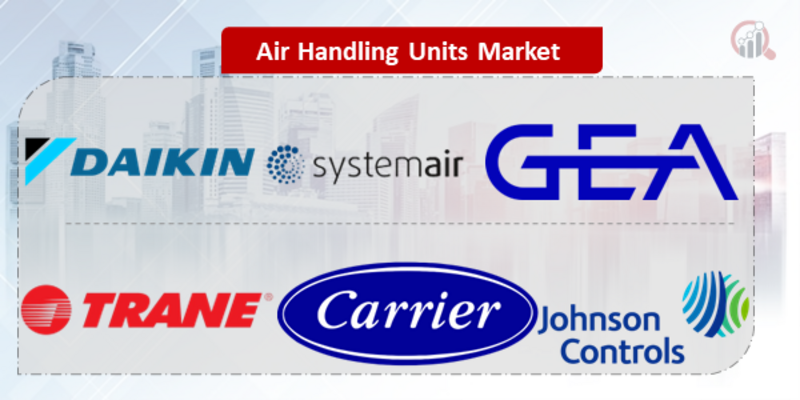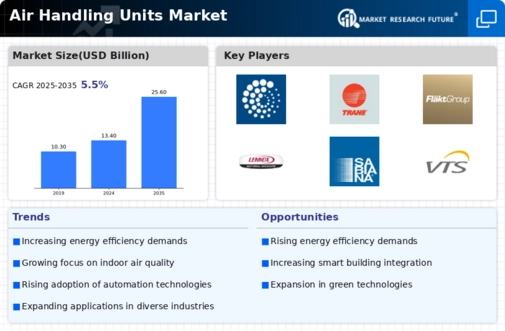Top Industry Leaders in the Air Handling Units Market

*Disclaimer: List of key companies in no particular order
The air handling unit (AHU) market hums with activity, powering climate control in buildings across the globe. This multi-billion dollar space is a battleground for established giants, innovative startups, and regional champions, all vying for a share of the air we breathe. Let's delve into the key strategies, market dynamics, and future trends shaping this dynamic landscape.
Top Companies in the Air Handling Units industry includes,
- Systemair (Sweden)
- Daikin Industries (Japan)
- Trane (Ireland)
- Carrier Corporation (US)
- Johnson control incorporation (Ireland)
- GEA Group (German)
- Flakt group (Germany)
- Lennox International (US)
- Sabiana (Italy)
- VTS Group (Luxemborg), and others.
Key Player Strategies:
Global Titans: Companies like Trane, Johnson Controls, and Carrier leverage their extensive experience, global reach, and diverse product portfolios to maintain their dominance. They cater to a wide range of building types and capacities, prioritizing reliability, efficiency, and comprehensive solutions. Carrier's AquaChill series exemplifies their focus on innovative and efficient chiller technology for AHUs.
Technology Disruptors: Startups like Daikin Applied and Mitsubishi Heavy Industries Climate Control Systems (MHI-CCS) are disrupting the market with cutting-edge technologies like variable refrigerant flow (VRF) systems, smart controls, and cloud-based monitoring. They cater to tech-savvy customers seeking high efficiency, remote management, and data-driven optimization. Daikin's VRV IV+ systems showcase their focus on intelligent and energy-efficient AHU solutions.
Cost-Effective Challengers: Chinese manufacturers like Gree and Midea are making waves with competitively priced AHUs, targeting budget-conscious buyers. They focus on value for money, offering basic functionalities without compromising quality. Gree's G-Tech inverter technology exemplifies their commitment to affordable efficiency in AHUs.
Sustainability Champions: Companies like Danfoss and Lennox prioritize eco-friendly practices, utilizing recycled materials, offering low-GWP refrigerants, and promoting energy-efficient solutions. They cater to environmentally conscious customers and leverage sustainability as a competitive advantage. Danfoss' Turbocor compressors illustrate their focus on energy-efficient and sustainable cooling technology for AHUs.
Factors for Market Share Analysis:
Product Portfolio Breadth: Offering a diverse range of AHUs for various building types (offices, hospitals, factories) and sizes caters to a wider customer base. Companies with comprehensive portfolios gain an edge.
Technology Innovation: Investing in R&D for next-generation technologies like intelligent controls, cloud-based platforms, and energy-efficient designs is crucial for staying ahead of the curve. Companies leading in innovation attract early adopters.
Cost and Affordability: Balancing advanced features with competitive pricing is vital for mass adoption, particularly in budget-sensitive sectors. Companies offering cost-effective solutions without compromising quality stand out.
Energy Efficiency and Sustainability: Meeting stringent energy regulations, utilizing low-carbon refrigerants, and minimizing environmental impact are becoming increasingly important. Companies demonstrating environmental consciousness attract both ethical clients and regulatory benefits.
New and Emerging Trends:
Building Intelligence Integration: Integrating AHUs with smart building automation platforms enhances energy management, optimizes comfort, and facilitates predictive maintenance. Companies offering seamless integration solutions cater to the demand for connected buildings.
Cloud-Based Monitoring and Control: Real-time remote monitoring and control capabilities via cloud platforms offer enhanced performance management, troubleshooting ease, and data-driven optimization. Companies providing these features attract customers seeking centralized control and data insights.
Focus on Indoor Air Quality (IAQ): Providing solutions for improved IAQ through air filtration, ventilation systems, and monitoring technologies is gaining traction due to health concerns and evolving regulations. Companies addressing IAQ needs stand out, catering to building healthier environments.
Modular and Pre-Fabricated Systems: Prefabricated AHU systems offer faster installation, easier maintenance, and potentially lower costs. Companies adopting modularity cater to the demand for faster construction and efficient project management.
Overall Competitive Scenario:
The AHU market is a dynamic and complex space with diverse players employing varied strategies. Established giants leverage their reach and diverse portfolios, while technology disruptors introduce innovative features. Cost-effective challengers cater to budget-conscious buyers, and sustainability champions attract environmentally conscious customers. Factors like product portfolio, technological innovation, affordability, and energy efficiency play a crucial role in market share analysis. New trends like building intelligence integration, cloud-based control, IAQ focus, and modular systems offer exciting growth opportunities. To succeed in this evolving market, players must prioritize innovation, cater to diverse customer needs, embrace sustainable practices, and explore technology-driven solutions. By aligning their strategies with market trends and customer demands, they can breathe easy and secure a commanding position in this competitive landscape.
Industry Developments and Latest Updates:
Systemair (Sweden):
- Date: December 15, 2023
- Source: Press release
- Development: Launched a new energy-efficient AHU series, the TopVent Green, specifically designed for low-energy buildings. It boasts EC fans, heat recovery options, and advanced controls for optimal performance and minimal energy consumption.
Trane (Ireland):
- Date: December 06, 2023
- Source: Company website
- Development: Introduced a new line of AHUs with enhanced modularity and customization options, allowing for easier installation and adaptation to diverse building requirements.
Carrier Corporation (US):
- Date: October 27, 2023
- Source: Financial report
- Development: Announced investments in R&D for next-generation AHUs with AI-powered controls and self-diagnostic capabilities, aiming to improve efficiency, maintenance, and overall building performance.
Johnson Controls Incorporation (Ireland):
- Date: December 19, 2023
- Source: Industry event presentation
- Development: Showcased a prototype AHU equipped with an innovative heat pump system that utilizes waste heat from building operations for space heating and hot water generation, promoting energy efficiency and sustainability.
GEA Group (Germany):
- Date: November 10, 2023
- Source: Press release
- Development: Acquired a leading manufacturer of specialized AHUs for the pharmaceutical and healthcare industries, expanding their reach in critical environment control applications.









